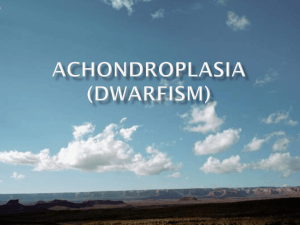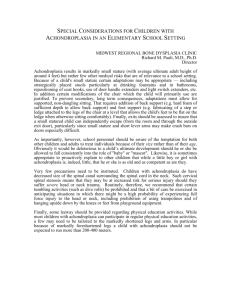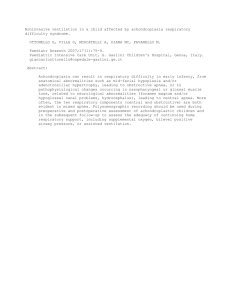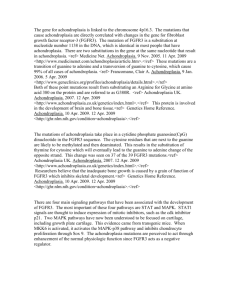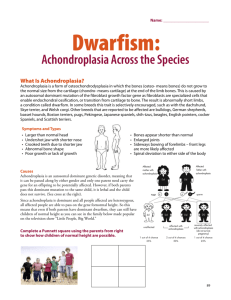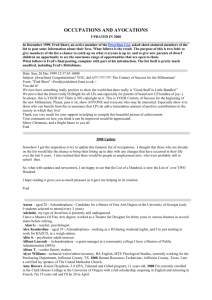Emerging research and potential treatments in achondroplasia and
advertisement
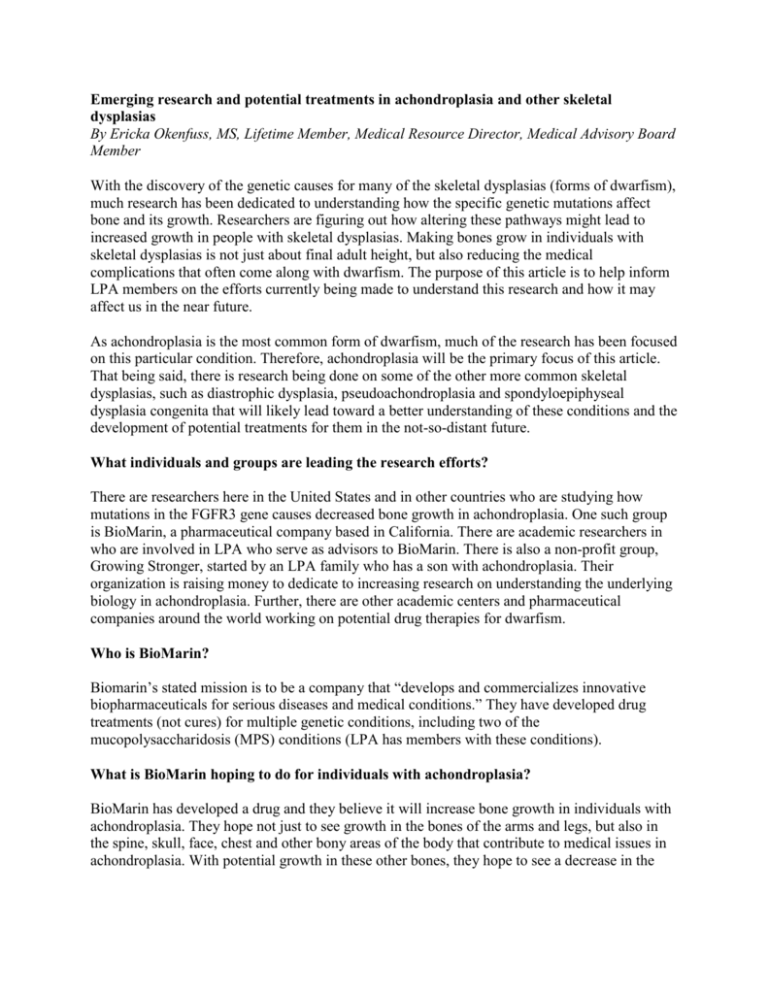
Emerging research and potential treatments in achondroplasia and other skeletal dysplasias By Ericka Okenfuss, MS, Lifetime Member, Medical Resource Director, Medical Advisory Board Member With the discovery of the genetic causes for many of the skeletal dysplasias (forms of dwarfism), much research has been dedicated to understanding how the specific genetic mutations affect bone and its growth. Researchers are figuring out how altering these pathways might lead to increased growth in people with skeletal dysplasias. Making bones grow in individuals with skeletal dysplasias is not just about final adult height, but also reducing the medical complications that often come along with dwarfism. The purpose of this article is to help inform LPA members on the efforts currently being made to understand this research and how it may affect us in the near future. As achondroplasia is the most common form of dwarfism, much of the research has been focused on this particular condition. Therefore, achondroplasia will be the primary focus of this article. That being said, there is research being done on some of the other more common skeletal dysplasias, such as diastrophic dysplasia, pseudoachondroplasia and spondyloepiphyseal dysplasia congenita that will likely lead toward a better understanding of these conditions and the development of potential treatments for them in the not-so-distant future. What individuals and groups are leading the research efforts? There are researchers here in the United States and in other countries who are studying how mutations in the FGFR3 gene causes decreased bone growth in achondroplasia. One such group is BioMarin, a pharmaceutical company based in California. There are academic researchers in who are involved in LPA who serve as advisors to BioMarin. There is also a non-profit group, Growing Stronger, started by an LPA family who has a son with achondroplasia. Their organization is raising money to dedicate to increasing research on understanding the underlying biology in achondroplasia. Further, there are other academic centers and pharmaceutical companies around the world working on potential drug therapies for dwarfism. Who is BioMarin? Biomarin’s stated mission is to be a company that “develops and commercializes innovative biopharmaceuticals for serious diseases and medical conditions.” They have developed drug treatments (not cures) for multiple genetic conditions, including two of the mucopolysaccharidosis (MPS) conditions (LPA has members with these conditions). What is BioMarin hoping to do for individuals with achondroplasia? BioMarin has developed a drug and they believe it will increase bone growth in individuals with achondroplasia. They hope not just to see growth in the bones of the arms and legs, but also in the spine, skull, face, chest and other bony areas of the body that contribute to medical issues in achondroplasia. With potential growth in these other bones, they hope to see a decrease in the serious complications of achondroplasia, such as spinal stenosis, foramen magnum (opening at the base of the skull) stenosis/compression, obstructive sleep apnea and ear infections. How does the drug work? In order to understand this, we need to know how the achondroplasia mutation in FGFR3 affects bones. FGFR3 is a receptor (a protein on the surface of the cell) and regulates bone growth. Its specific role is to slow down bone growth and balance out the effects of other receptors and molecules that promote growth. Think of these as the red and green lights of bone growth. FGFR3 is a red light. When it is “on,” bone growth slows or stops. When it is “off,” bone growth can go or accelerate. The mutation that causes achondroplasia causes FGFR3’s red light to be turned on too much of the time causing less bone growth than someone without the mutation. BioMarin’s drug is a molecule that works in the same pathway as FGFR3. Their drug, called BMN-111, has been shown to block the effects of too much signaling from the achondroplasia FGFR3 mutation. The idea is that adding a green light to the growth pathway of FGFR3 will hopefully make growth closer to average. What does the drug do in animals? In mice with achondroplasia, BioMarin reported that BMN-111 “restored normal growth.” The drug affected all of the bones affected by achondroplasia (in the mouse model of achondroplasia), not just the bones of the limbs. They saw growth in the spinal canal and the foramen magnum and changes in the shape of the head and face. BioMarin also showed that this drug increased growth in animals not affected with dwarfism. What is the current timeline for the testing and marketing of this drug? BioMarin is currently testing the BMN-111 drug in average statured adults to determine if it is safe for humans. Once it is considered by the FDA (US Food and Drug Administration) to be safe, BioMarin intends to begin a trial in children with achondroplasia. They hope to start this in late 2012 or early 2013. In the study, children with achondroplasia will either receive the drug or a placebo for 12 months. During that time, the patient would be evaluated for changes in growth, their proportions (by measurements), the way the bones look on x-rays, the size of the foramen magnum and other parameters. If the first phase proves the drug is safe and there are no serious side effects noted in the initial months of the second phase, BioMarin hopes to start testing the effects of this drug on the foramen magnum in babies with achondroplasia who are at highest risk for this complication. How would someone take this drug? Daily injections into the skin. How long would someone take this drug? This drug could only be effective while an individual is still growing. Therefore, people would stop using this treatment when they stop growing at the end of puberty. Will families be able to afford this drug? If it is shown to be effective, even partially, it is anticipated that insurance companies including Medicaid would cover this drug, even though it will have an extraordinary cost (hundreds of thousands of dollars per year per patient). Precedent has been set with the drug treatments for the MPS conditions and other rare genetic conditions that are equally expensive and are given to the patient for their lifetime. It is possible that families will have a significant share of cost if they have a high deductible and/or co-pay. What don’t we know about this drug? If it is safe in humans. If it can be tolerated by children. If it will cause any significant changes in the growth and development of a child with achondroplasia. If this drug works, what might it be able to do? It could reduce the medical complications of achondroplasia. It could: increase overall height. enlarge the foramen magnum and the spinal canal. allow the long bones to grow at a similar rate and therefore be straighter. increase the growth of the face and reduce sleep apnea and ear infections. What other research is there? There are many researchers in the US and around the world that are looking at other aspects of the FGFR3 pathway, any of which could lead to a potential treatment for achondroplasia. What is being done to support research in achondroplasia and skeletal dysplasias? Because each skeletal dysplasia (form of dwarfism) is a rare condition, there is not a lot of funding available in terms of research grants from institutions like the National Institutes of Health. LPA does not fund or support medical research as part of its mission, as other support groups for specific genetic diagnoses often do. A new non-profit organization, Growing Stronger, has been recently founded. Its mission is “improve the quality of life of little people through supporting research.” Growing Stronger is currently supporting research in two labs in the United States. Both of these labs are looking at the FGFR3/achondroplasia pathway in an effort to determine ways to promote growth. Growing Stronger is looking for other projects to support and have availed themselves to receive input from LPA. Other organizations such as the March of Dimes are supporting researchers studying the pathways affected by the FGFR3 gene. Note from LPA: Little People of America does not endorse the work of BioMarin or any related company that pursues dwarfism research. At this time, LPA’s goal is to stay updated on these activities and to keep the membership informed. As more information about such research becomes available, LPA plans to develop position papers related to research developments.
